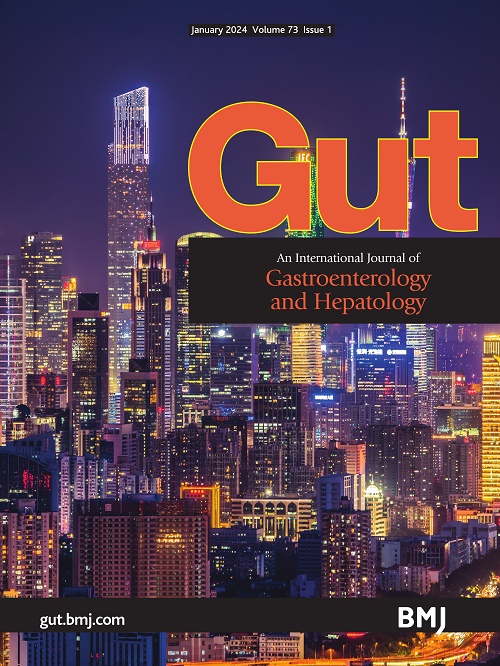Tumour-intrinsic alterations and stromal matrix remodelling promote Wnt-niche independence during diffuse-type gastric cancer progression
IF 25.8
1区 医学
Q1 GASTROENTEROLOGY & HEPATOLOGY
引用次数: 0
Abstract
Background Development of diffuse-type gastric cancer (DGC) starts with intramucosal lesions that are primarily composed of differentiated, non-proliferative signet ring cells (SRCs). These indolent lesions can advance into highly proliferative and metastatic tumours, which requires suppression of DGC cell differentiation. Objective Our goal was to identify molecular changes contributing to the progression of indolent to aggressive DGC lesions. Design We conducted spatial transcriptomic analysis of patient tumours at different stages of hereditary DGC, comparing transcriptional differences in tumour cell populations and tumour-associated cells. We performed functional analysis of identified changes in a human gastric ( CDH1 KO) organoid model recapitulating DGC initiation. Results Our analysis reveals that distinct DGC cell populations exhibit varying levels of Wnt-signalling activity, and high levels of Wnt signalling prevent differentiation into SRCs. We identify multiple adaptations during DGC progression that converge on Wnt signalling, allowing tumour cells to remain in an undifferentiated state as they disseminate away from the gastric stem cell niche. First, DGC cells establish a cell-autonomous source for Wnt-pathway activation through upregulated expression of Wnt-ligands and ‘secreted frizzled-related protein 2’ ( SFRP2 ) that potentiates ligand-induced Wnt signalling. Second, early tumour development is marked by extracellular matrix remodelling, including increased deposition of collagen I whose interactions with DGC cells suppress their differentiation in the absence of exogenous Wnt ligands. Conclusions Our findings demonstrate that tumour cell-derived ligand expression and extracellular matrix remodelling sustain Wnt signalling during DGC progression. These complementary mechanisms promote niche independence enabling expansion of undifferentiated DGC cells needed for the development of advanced tumours. Data are available on reasonable request. All data relevant to the study are included in the article or uploaded as supplementary information. Normalised and averaged data of the Nanostring DSP analysis has been added as a supplementary table. Raw counts of the Nanostring DSP analysis and whole exome sequencing data are available on request.在弥漫性胃癌进展过程中,肿瘤内在改变和基质重塑促进了wnt生态位的独立性
背景弥漫性胃癌(DGC)的发展始于粘膜内病变,主要由分化的非增殖性印戒细胞(src)组成。这些惰性病变可发展为高度增殖和转移性肿瘤,这需要抑制DGC细胞分化。目的:我们的目的是确定分子变化有助于惰性到侵袭性DGC病变的进展。我们对遗传性DGC不同阶段的患者肿瘤进行了空间转录组学分析,比较肿瘤细胞群和肿瘤相关细胞的转录差异。我们对重现DGC起始的人胃(CDH1 KO)类器官模型中确定的变化进行了功能分析。我们的分析表明,不同的DGC细胞群表现出不同水平的Wnt信号活性,高水平的Wnt信号传导阻止了向src的分化。我们确定了DGC进展过程中的多种适应,这些适应聚集在Wnt信号上,允许肿瘤细胞在远离胃干细胞生态位时保持未分化状态。首先,DGC细胞通过上调Wnt配体和“分泌卷曲相关蛋白2”(SFRP2)的表达,建立了Wnt通路激活的细胞自主来源,SFRP2增强了配体诱导的Wnt信号传导。其次,早期肿瘤发展的特征是细胞外基质重塑,包括胶原I沉积增加,胶原I与DGC细胞的相互作用在缺乏外源Wnt配体的情况下抑制了DGC细胞的分化。结论:我们的研究结果表明,肿瘤细胞来源的配体表达和细胞外基质重塑在DGC进展过程中维持了Wnt信号。这些互补机制促进了生态位独立性,使晚期肿瘤发展所需的未分化的DGC细胞能够扩增。如有合理要求,可提供资料。所有与研究相关的数据都包含在文章中或作为补充信息上传。将纳米管柱DSP分析的归一化和平均数据作为补充表添加。原始计数的纳米串DSP分析和全外显子组测序数据可按要求提供。
本文章由计算机程序翻译,如有差异,请以英文原文为准。
求助全文
约1分钟内获得全文
求助全文
来源期刊

Gut
医学-胃肠肝病学
CiteScore
45.70
自引率
2.40%
发文量
284
审稿时长
1.5 months
期刊介绍:
Gut is a renowned international journal specializing in gastroenterology and hepatology, known for its high-quality clinical research covering the alimentary tract, liver, biliary tree, and pancreas. It offers authoritative and current coverage across all aspects of gastroenterology and hepatology, featuring articles on emerging disease mechanisms and innovative diagnostic and therapeutic approaches authored by leading experts.
As the flagship journal of BMJ's gastroenterology portfolio, Gut is accompanied by two companion journals: Frontline Gastroenterology, focusing on education and practice-oriented papers, and BMJ Open Gastroenterology for open access original research.
 求助内容:
求助内容: 应助结果提醒方式:
应助结果提醒方式:


